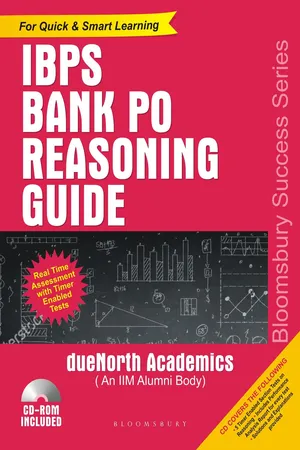
- 282 pages
- English
- ePUB (mobile friendly)
- Available on iOS & Android
IBPS Bank PO Reasoning Guide
About This Book
This book has been designed to give the users conceptual clarity and ample opportunity to practice upon the questions from all the concepts essential for IBPS Bank PO examination. To assess one's preparation level, previous years papers and mock papers are provided in the book. Authors have taken utmost care to get the users have a real feel of the examination through the questions in the book as well as in CD. CD provides timer based test papers with state-of-the-art analysis of individual's performance that will help the students crack the examination. 1. Covers all the topics relevant for Bank PO examinations
2. Ample number of worked out examples and practice questions with solutions
3. Content prepared by teachers with more than twelve years of experience in training
4. CD containing five test papers with timer and analysis
Previous years' papers and mock papers for practice
Frequently asked questions
Information
 | Series |


Table of contents
- Cover
- Half Title
- Title Page
- Copyright
- Contents
- 1. Series
- 2. Coding Decoding
- 3. Blood relation
- 4. Input Output
- 5. Directions
- 6. Syllogism
- 7. Sequencing and Arrangement
- 8. Cubes
- 9. Ranking test
- 10. Statement Assumption
- 11. Statement Conclusion
- 12. Statement Argument
- 13. Data Interpretation
- 14. Set Presentation
- 15. Symbol Based questions
- 16. IBPS Bank PO paper (Based upon 2012 pattern)
- 17. Mock Test 1 - Reasoning Ability